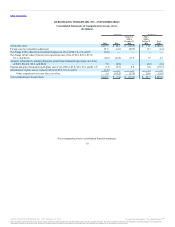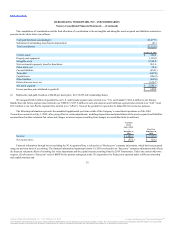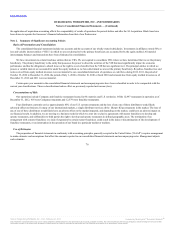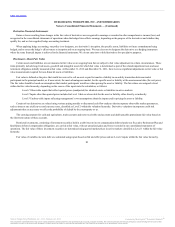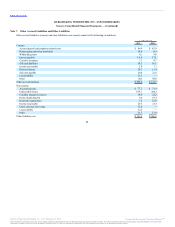Burger King 2012 Annual Report Download - page 81
Download and view the complete annual report
Please find page 81 of the 2012 Burger King annual report below. You can navigate through the pages in the report by either clicking on the pages listed below, or by using the keyword search tool below to find specific information within the annual report.
Table of Contents
include, but are not limited to, a significant under-performance relative to expected and/or historical results (two consecutive years of negative comparable sales
or operating cash flows); significant negative industry or economic trends; knowledge of transactions involving the sale of similar property at amounts below
the carrying value; or our expectation to dispose of long-lived assets before the end of their estimated useful lives. The impairment test for long-lived assets
requires us to assess the recoverability of long-lived assets by comparing their net carrying value to the sum of undiscounted estimated future cash flows
directly associated with and arising from use and eventual disposition of the assets. If the net carrying value of a group of long-lived assets exceeds the sum of
related undiscounted estimated future cash flows, we must record an impairment charge equal to the excess, if any, of net carrying value over fair value.
Long-lived assets are grouped for recognition and measurement of impairment at the lowest level for which identifiable cash flows are largely independent
of the cash flows of other assets. Certain long-lived assets and related liabilities are grouped together for impairment testing at the operating market level (based
on geographic areas) in the case of the United States and Canada. The operating market groupings within the United States and Canada are predominantly
based on major metropolitan areas within the United States and Canada. These operating market definitions are based upon the following primary factors:
• management views profitability of the restaurants within the operating markets as a whole, based on cash flows generated by a portfolio of
restaurants, rather than by individual restaurants, and area managers receive incentives on this basis; and
• we do not evaluate individual restaurants to build, acquire or close independent of an analysis of other restaurants in these operating markets.
In countries in which we have a smaller number of restaurants, most operating functions and advertising are performed at the country level, and shared
by all restaurants in the country. As a result, we have defined operating markets as the entire country in the case of Spain, Mexico and Germany.
Other assets consist primarily of investments in equity method investees and the noncurrent portion of deferred financing costs. Investments in which
we have significant influence over the investee are accounted for using the equity method. Our share of investee net income or loss is classified as a component
of other income (expense), net in our consolidated statements of operations. We evaluate our investments in equity method investments for impairment
whenever events occur or circumstances change in a manner that indicates our investment may not be recoverable. We did not record impairment charges
related to equity method investments for 2012, 2011, the period of October 19, 2010 to December 31, 2010, the period of July 1, 2010 to October 18, 2010 or
fiscal 2010.
Other comprehensive income (loss) refers to revenues, expenses, gains and losses that are included in comprehensive income (loss), but are excluded
from net income (loss) as these amounts are recorded directly as an adjustment to stockholders’ equity, net of tax. Our other comprehensive income (loss) is
comprised of unrealized gains and losses on foreign currency translation adjustments, unrealized gains and losses on hedging activity, net of tax, and
minimum pension liability adjustments, net of tax.
80
Source: Burger King Worldwide, Inc., 10-K, February 22, 2013 Powered by Morningstar® Document Research℠
The information contained herein may not be copied, adapted or distributed and is not warranted to be accurate, complete or timely. The user assumes all risks for any damages or losses arising from any use of this
information, except to the extent such damages or losses cannot be limited or excluded by applicable law. Past financial performance is no guarantee of future results.


